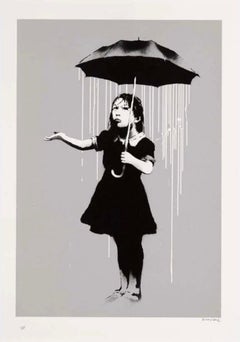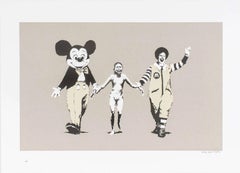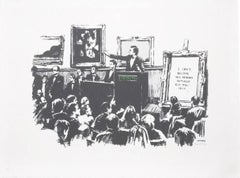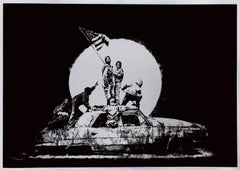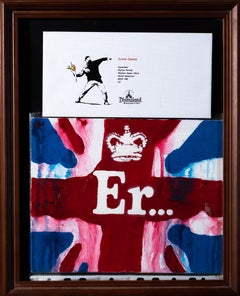Banksy Paintings
Of the numerous feats that Banksy has accomplished over the course of his career as an international artist, activist and filmmaker, perhaps the most astonishing is that while he is among the most famous figures in street art, he has managed to remain completely anonymous.
There is a method behind the madness, however. Banksy maintains that he chooses to conceal his identity to make a more democratic impact with his work, the themes of which include criticism of world leaders, consumerism and terrorism.
Although not much is known about Banksy — he sent a photo of himself with a paper bag on his head to Time magazine for a profile — it is believed that he was born in the city of Bristol, in southwest England, circa 1974. Wit, irreverence, dark humor and activism come together in his work, which spans graffiti, paintings, prints, sculptures and filmmaking. (His film, Exit Through the Gift Shop, which focuses on another street artist known as Mr. Brainwash, was nominated for Best Documentary Feature at the 2010 Academy Awards.)
Banksy began as a graffiti artist in his hometown in the early 1990s. He has found fame for his stenciled and spray-painted pieces, which are most often rooted in anti-war or antiestablishment messaging, appearing in cities such as London, New York and Los Angeles and for his “stunts” that are intended to subvert and provoke the art world. One particularly memorable stunt took place in 2018, when, as soon as one of his paintings sold at auction — Girl with a Balloon, which fetched an extraordinary $1.4 million — it self-destructed and proceeded to partially shred itself. Banksy even snuck into the Louvre and hung his own version of the Mona Lisa in 2006. Despite his elusive persona and commitment to bringing art to the masses, Banksy is one of the most coveted artists at auctions across the world.
And his work is undeniably impactful.
At a record-breaking auction organized by Damien Hirst, Bono and others to benefit AIDS charities in 2008, Banksy’s Keep It Spotless — a modified Hirst painting — fetched nearly $2 million. In May of 2020, Banksy donated Game Changer, a painting that honors UK healthcare workers, to Southampton General Hospital. When it went to auction in 2021, it sold for more than $23 million at Christie's in London. All proceeds went to the National Health Service.
Find original Banksy art for sale on 1stDibs.
1990s Street Art Banksy Paintings
Spray Paint
2010s Street Art Banksy Paintings
Fabric
21st Century and Contemporary Banksy Paintings
21st Century and Contemporary Banksy Paintings
21st Century and Contemporary Banksy Paintings
21st Century and Contemporary Banksy Paintings
Screen
Early 2000s Street Art Banksy Paintings
Spray Paint
2010s Photorealist Banksy Paintings
Oil, Canvas
16th Century Old Masters Banksy Paintings
Ink, Gouache, Pen
20th Century Modern Banksy Paintings
Gouache, Paper
2010s Abstract Banksy Paintings
Paper, Screen
Late 17th Century Old Masters Banksy Paintings
Oil, Canvas
20th Century Surrealist Banksy Paintings
Screen
Mid-17th Century Baroque Banksy Paintings
Copper
1980s Pop Art Banksy Paintings
Canvas, Screen
21st Century and Contemporary Photorealist Banksy Paintings
Canvas, Oil
Irina TrushkovaFlorence -original still life painting-original realism still life oil painting, 2023
2010s Contemporary Banksy Paintings
Wood Panel, Screen, Color Pencil, Acrylic
21st Century and Contemporary Abstract Banksy Paintings
Oil, Canvas
20th Century Other Art Style Banksy Paintings
Screen
21st Century and Contemporary Banksy Paintings
Spray Paint

